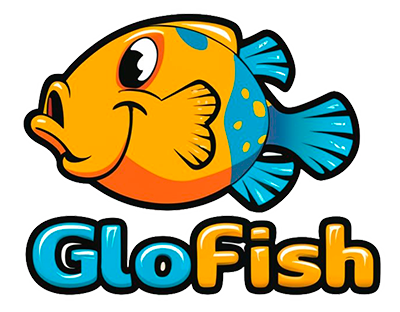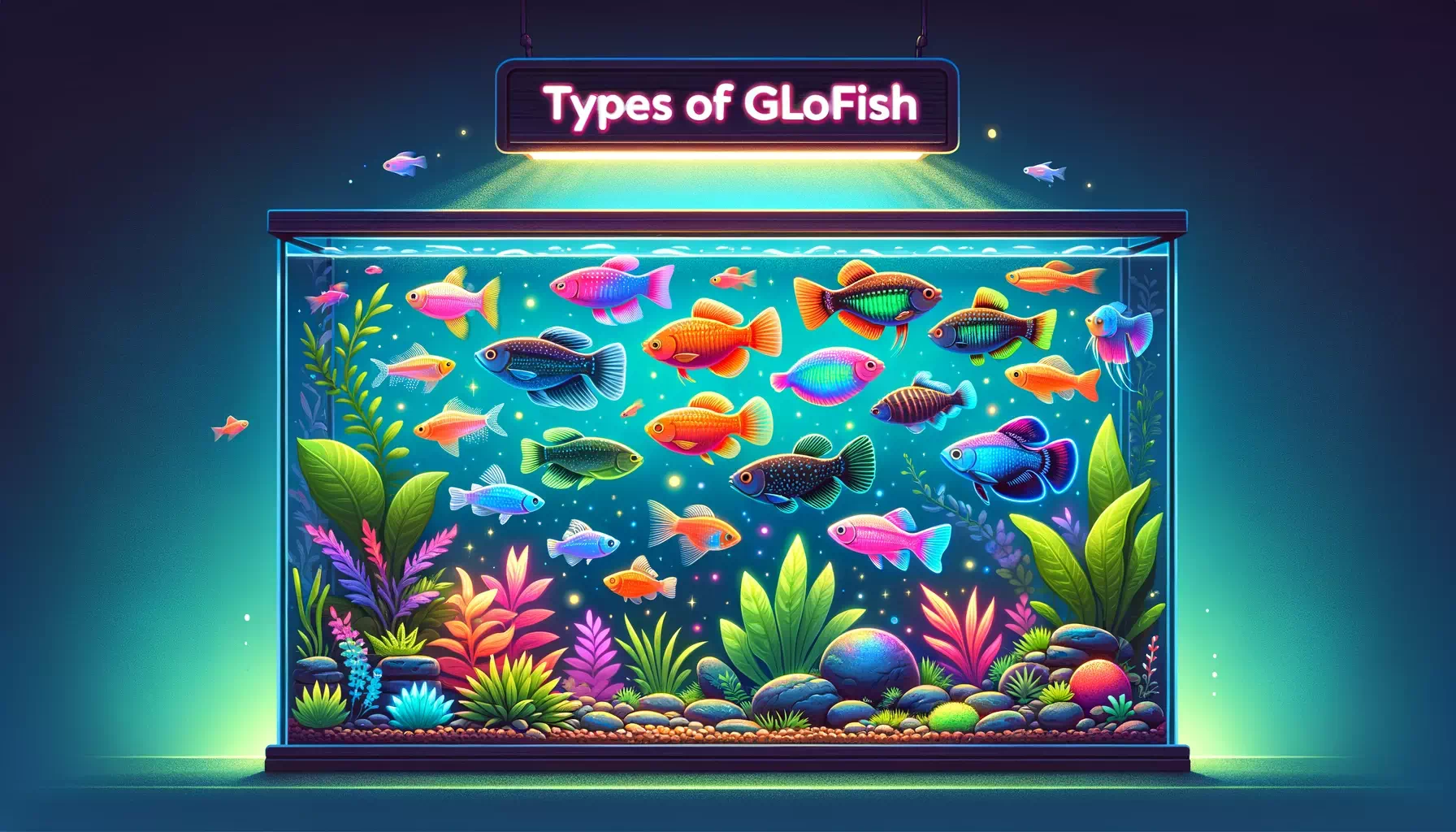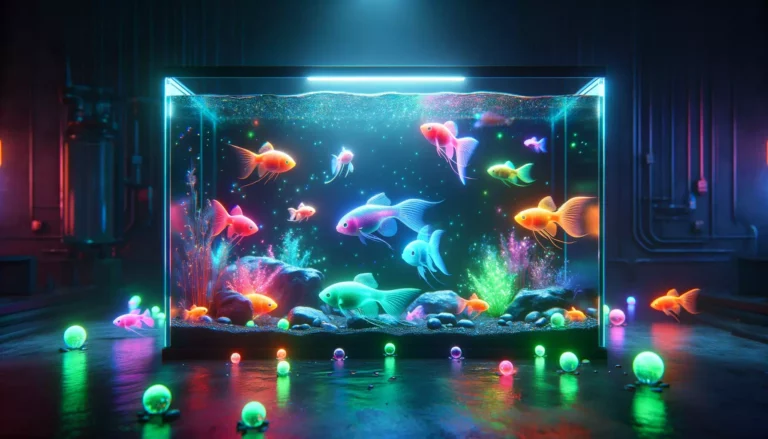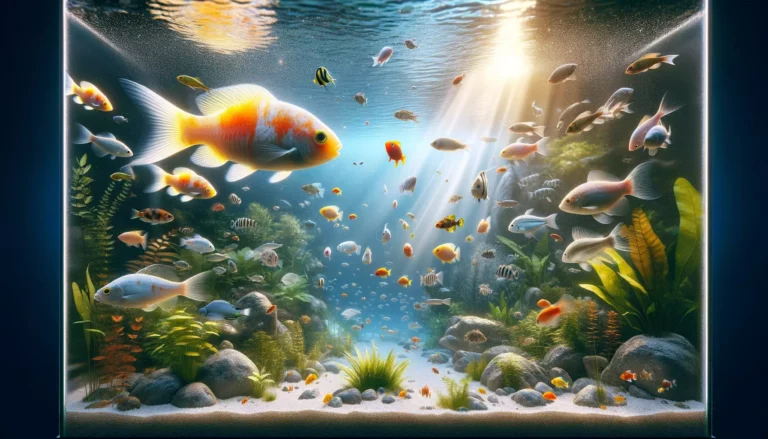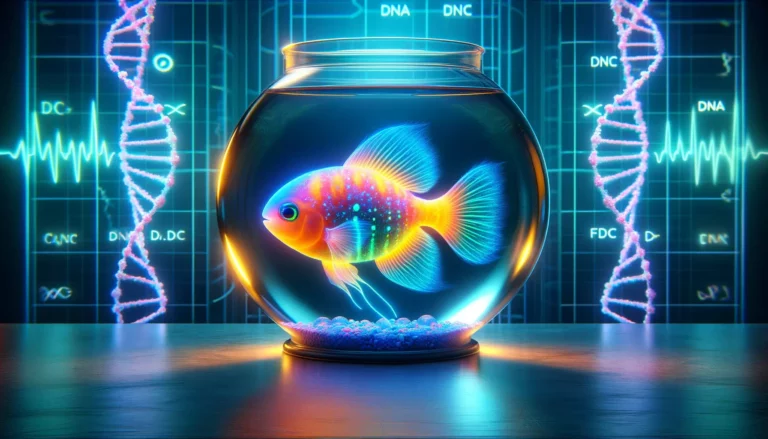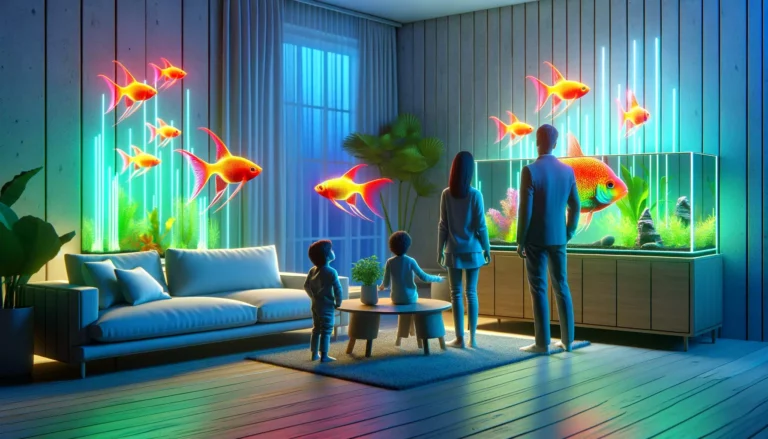The Ultimate Guide to GloFish: Types, Characteristics, and Colors
GloFish are not just any ordinary fish you find in an aquarium. They are the result of remarkable genetic engineering. Originally, scientists developed them to detect environmental pollution. They introduced a fluorescence gene into the fish. This gene made the fish glow in the presence of pollutants. Over time, these glowing features became popular in the pet trade. Now, GloFish are adored for their bright colors and unique glow.
Their popularity among aquarists has soared over the years. The unique glow of GloFish adds an extraordinary flair to any aquarium. They come in a spectrum of vibrant colors. These range from neon pink to electric green. Each color is a result of careful genetic selection. This makes them a favorite among beginners and experienced aquarists alike.
In this post, we aim to guide you through the vibrant world of GloFish. We’ll explore the different types available. Each type has its own unique characteristics and care needs. Our goal is to provide a clear understanding of these beautiful creatures. We want you to feel confident in caring for them.
We’ll dive into the various species of GloFish. These include Tetras, Barbs, and Danios. Each species comes with its own set of care instructions. We’ll also explore the stunning color palette these fish offer. From bold blues to radiant reds, the choices are mesmerizing.
By the end of this post, you’ll have a comprehensive understanding of GloFish. You’ll know about their types, their needs, and the colors they come in. This knowledge will help you create a thriving environment for your GloFish. Happy aquascaping!
Understanding GloFish
GloFish are a unique and fascinating addition to the world of aquariums. They’re not found in the wild but are created through genetic modification. Scientists insert genes from fluorescent marine organisms into regular fish. This results in fish that glow under ultraviolet light. Their vibrant colors come in a range of shades, like neon green, bright yellow, and deep red. These glowing colors are not painted or dyed but are a part of the fish’s genetic makeup.
GloFish stand out for their ability to glow, a feature that makes them popular in home aquariums. They were initially developed for scientific research. The goal was to create fish that could signal environmental changes. For example, they would glow in the presence of pollutants. Now, they are bred for their aesthetic appeal. Their care requirements are similar to their non-modified counterparts.
Legal and Ethical Considerations
When it comes to keeping GloFish, there are important legal and ethical aspects to consider. Legally, GloFish are patented and licensed under specific regulations. This means breeding GloFish for commercial sale is not allowed without a license. In the United States, they are legal in most states. However, some regions have restrictions or bans on genetically modified organisms, including GloFish. It’s crucial to check local laws before purchasing or keeping them.
Ethically, the creation and sale of GloFish have sparked debate. Some express concerns about genetic modification in pets. Others see GloFish as a step forward in genetic research with potential benefits. It’s essential to make an informed decision. Consider the impact of supporting the GloFish industry. It’s not just about enjoying their beauty but also understanding the science and ethics behind them.
Exploring the Types of GloFish
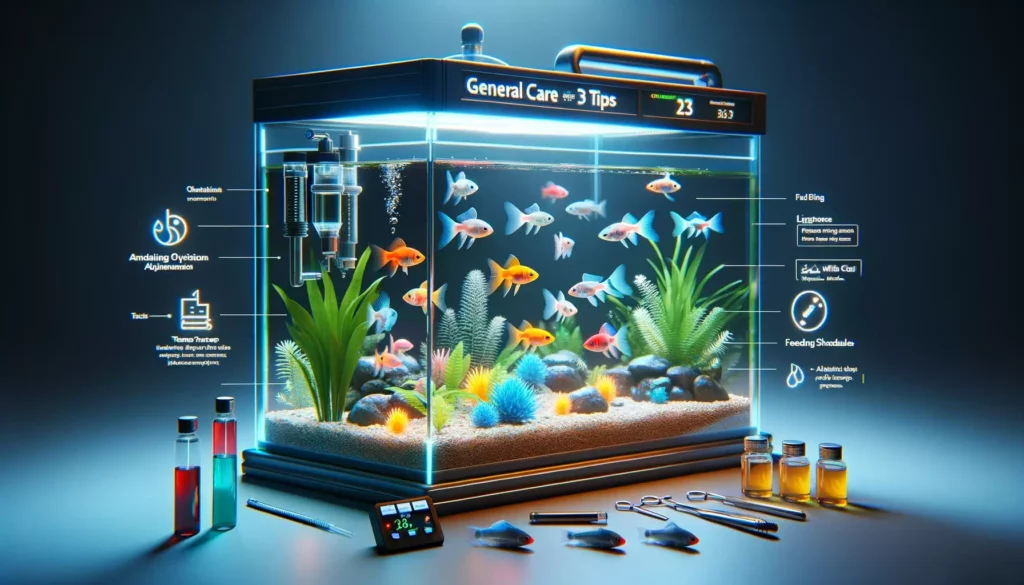
GloFish come in a variety of types, each with its unique charm and care needs. The main types include Tetras, Barbs, and Danios. These are common fish species that have been genetically modified to glow. Let’s dive into each type and understand their specific characteristics.
Tetras are one of the most popular GloFish. They are small, usually reaching about 2 inches in length. Known for their peaceful nature, they thrive in groups. Tetras prefer a well-planted aquarium with plenty of space to swim. They enjoy a diet of standard flake food and occasional live or frozen treats.
Barbs are another type of GloFish, slightly larger and more active than Tetras. They can grow up to 3 inches. Barbs are known for their playful behavior. They do well in a spacious tank with areas for hiding. Barbs are omnivores, enjoying a varied diet. They are best kept with other active fish to match their energy levels.
Danios are the hardy and adaptable members of the GloFish family. They typically grow to about 2-2.5 inches. Danios are fast swimmers and enjoy a tank with plenty of room for movement. They are also known for being tolerant of a range of water conditions. This makes them ideal for beginners. Danios do well on a diet of flake food supplemented with occasional live or frozen snacks.
Each type of GloFish brings its own unique beauty and personality to an aquarium. Understanding their specific needs is key to providing a healthy and vibrant environment for them. Whether you prefer the calm swaying of Tetras, the playful antics of Barbs, or the energetic swimming of Danios, there’s a GloFish for every aquarium enthusiast.
Color Variations of GloFish

GloFish are celebrated for their stunning array of colors. Each type of GloFish – Tetras, Barbs, and Danios – comes in various vibrant hues. This color variety adds an extraordinary visual appeal to any aquarium.
Tetras are available in brilliant colors like neon green, bright blue, and pink. These colors make them stand out in a planted tank. Their small size combined with these bright colors creates a dazzling display.
Barbs, a bit larger, showcase shades like orange, purple, and yellow. The contrast between these colors and their playful behavior is a delight to watch. They bring a dynamic energy to the tank with their vivid colors.
Danios, known for their speed, come in striking red, green, and blue. The swift movement of these brightly colored fish adds a lively ambiance to the aquarium. Their hardiness, paired with these attractive colors, makes them a favorite among beginners.
The illustration below showcases the different color variations of Tetras, Barbs, and Danios. Each type is distinctly drawn to highlight its unique shape and color scheme. This colorful representation gives a clear idea of the beauty these fish can bring to your aquarium.
Understanding these color variations helps in creating a visually appealing and harmonious aquarium setup. Whether you prefer the calming blues and pinks of Tetras, the vibrant oranges and purples of Barbs, or the striking reds and greens of Danios, there’s a color palette for every aquarist’s taste.
General Care Tips for GloFish

Caring for GloFish involves a few essential practices that ensure their health and well-being. Firstly, the aquarium setup is crucial. A standard guideline is to provide at least 1-2 gallons of water per inch of fish. This ensures enough space for swimming and exploration. The tank should also have a proper filtration system to keep the water clean and oxygen-rich.
Water quality is paramount. Regular testing of pH levels, ammonia, nitrite, and nitrate levels is necessary. The ideal pH level for GloFish is between 6.5 and 7.5. Consistent water temperature, typically between 72-80°F (22-27°C), is also important. Regular water changes, about 10-25% weekly, help maintain a healthy environment.
Feeding GloFish requires a balanced diet. A mix of high-quality flake food and occasional treats like brine shrimp or bloodworms is ideal. It’s important to feed them in small amounts that they can consume in a few minutes. Overfeeding can lead to health issues and tank pollution.
Specific Recommendations for Different GloFish Types
Tetras: These peaceful fish prefer a planted tank with hiding spaces. They thrive in groups, so keeping a small school of them is ideal. Tetras do well with a diet of tropical flakes and occasional live food.
Barbs: Barbs are active and enjoy a tank with both open swimming spaces and hiding spots. They can be a bit nippy, so it’s best to keep them with similarly sized and tempered fish. A diet rich in varied nutrients, including vegetable flakes, suits them well.
Danios: Danios are adaptable and can tolerate a range of water conditions. They are active swimmers, so a longer tank is preferable for them. They are not fussy eaters; standard flake food with occasional variety works great for them.
Each GloFish type has unique needs, but proper care is straightforward. By following these general and specific guidelines, you can ensure a healthy, vibrant, and active life for your GloFish. Remember, the key to successful fishkeeping is consistency and attention to the specific needs of your aquatic pets.
Compatibility of GloFish with Other Fish
GloFish, known for their peaceful nature, can coexist with a variety of other fish species. However, selecting the right tank mates is crucial for a harmonious aquarium. Generally, GloFish are compatible with other non-aggressive, similarly sized fish.
Tetras do well with other small, peaceful fish. Ideal companions include other Tetras, small Rasboras, and Dwarf Gouramis. They prefer a calm environment, so avoid housing them with larger, aggressive fish.
Barbs are a bit more active and can be nippy, especially with fish that have long fins. Suitable tank mates include other Barbs, Danios, and smaller Catfish. Avoid keeping them with slow-moving or long-finned fish like Angelfish.
Danios are fast swimmers and can keep up with other active fish. They get along well with Barbs, Tetras, and some types of Gouramis and Catfish. Since they are active, they might stress slower, more timid fish.
Warnings about Potential Problems
When introducing GloFish to a community tank, there are potential problems to be aware of. Aggressive fish can bully or stress GloFish, leading to health issues. Conversely, GloFish like Barbs might nip at the fins of slower, long-finned fish.
Overcrowding is another concern. It can lead to stress, aggression, and health problems. Make sure to provide adequate space based on the number and size of fish in the tank.
Balancing the tank environment is key to a peaceful cohabitation. Monitor fish interactions, especially in the beginning. Ensure each species has enough space and hiding spots. This helps reduce stress and potential conflicts. By carefully selecting compatible tank mates, you can create a vibrant and harmonious aquarium.
Understanding Breeding of GloFish
Breeding GloFish, while fascinating, comes with its own set of rules and considerations. These genetically modified fish require careful breeding to maintain their unique characteristics. First, it’s important to distinguish the males from females. This can often be done by size and color intensity, with males typically being more vibrant and slimmer.
The breeding process for GloFish is similar to that of their non-modified counterparts. A breeding tank with appropriate conditions is essential. This includes optimal water temperature, pH levels, and a suitable environment for egg laying and fry development. For example, Tetras prefer softer water and a densely planted tank for spawning.
Feeding the breeding pair high-quality food enhances their health and breeding potential. After spawning, it’s crucial to either remove the eggs or the parents to prevent the adults from eating the eggs or fry. The fry usually hatch within a few days and require special care, including appropriate food and a safe tank environment.
Legal Restrictions on Breeding GloFish
Breeding GloFish carries significant legal implications. GloFish are patented and trademarked creatures. This means that unauthorized breeding and sale of GloFish is illegal. The patent covers the genetic modification that gives them their unique glow. Therefore, breeding them for commercial purposes is strictly regulated.
For hobbyists, it’s important to understand that breeding GloFish, even unintentionally, can have legal consequences. These fish are meant for enjoyment and education, not for unauthorized propagation. If you’re interested in breeding GloFish, it’s best to contact the company for guidance and to understand the legal framework.
In summary, while breeding GloFish can be an interesting venture, it’s surrounded by legal restrictions to protect the patented technology. This ensures the ethical treatment of these unique creatures and respects the intellectual property rights of the developers. For any breeding interest, seeking proper guidance and adhering to legal regulations is crucial.
Frequently Asked Questions About GloFish
Do GloFish need special care compared to regular fish?
No, GloFish care is similar to their non-glowing counterparts. They require a clean tank, proper diet, and appropriate water conditions.
Can GloFish breed with non-modified fish?
Yes, GloFish can breed with non-modified fish of the same species. However, the offspring may not inherit the GloFish’s glowing characteristics.
How long do GloFish live?
With proper care, GloFish can live as long as their non-modified counterparts, typically around 3-5 years, sometimes longer.
Do GloFish require a special light to glow?
GloFish are best viewed under blue or black light, which enhances their glowing effect. However, they do not require this light to survive.
Can I mix different types of GloFish in one tank?
Yes, you can mix different types of GloFish. Ensure the tank is large enough and the environment suits all types.
Conclusion
GloFish stand out as a unique and attractive choice for pet fish. Their vibrant colors and ease of care make them a favorite among both beginners and experienced aquarists. They bring a special glow to any aquarium, creating a mesmerizing underwater world.
GloFish are more than just pets; they’re a glimpse into the fascinating world of genetic science. Their glowing appearance is not only visually appealing but also a testament to the advancements in genetic research. Whether you’re a seasoned aquarist or just starting, GloFish offer a delightful and educational experience.
We encourage you to share your experiences with GloFish in the comments. Have you kept GloFish before? What tips do you have for new GloFish owners? Your insights and questions help create a community of informed and responsible fish enthusiasts. Let’s continue learning and sharing about the wonderful world of GloFish together.
